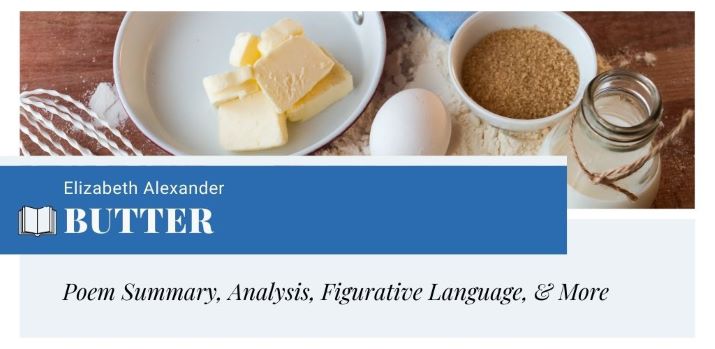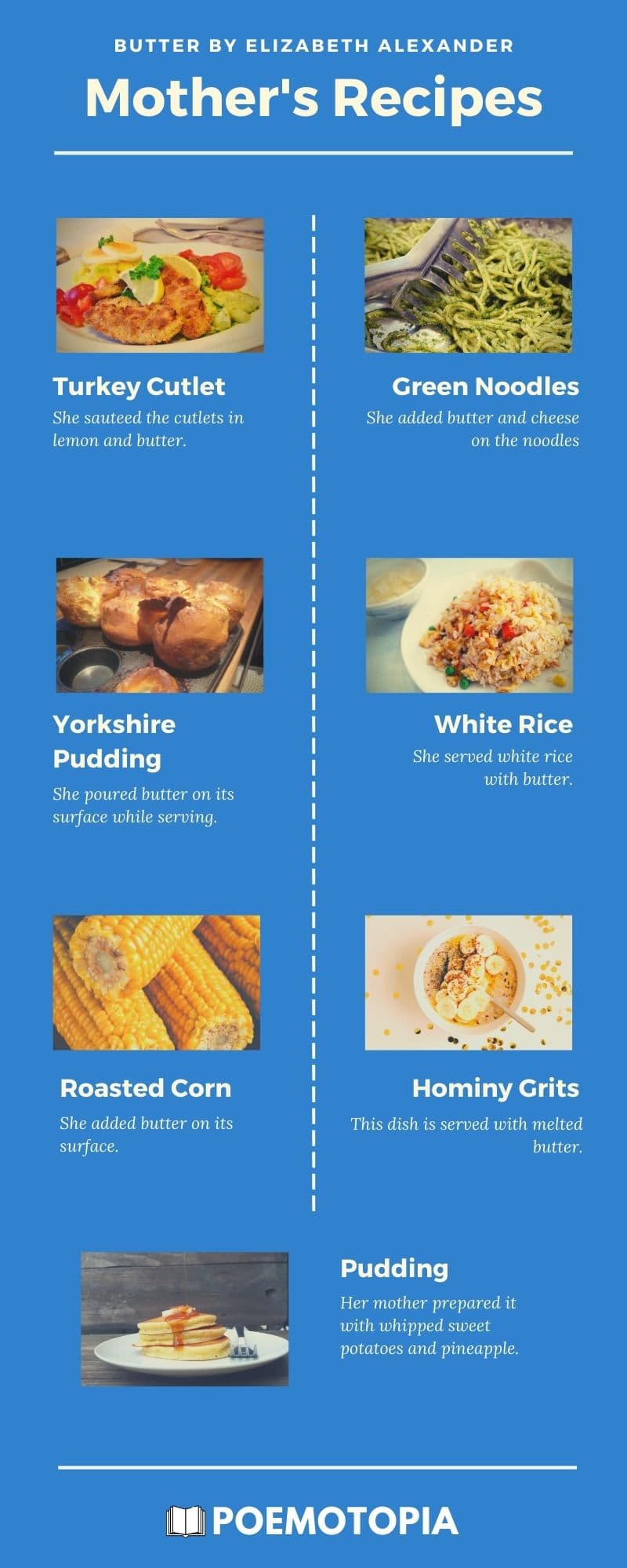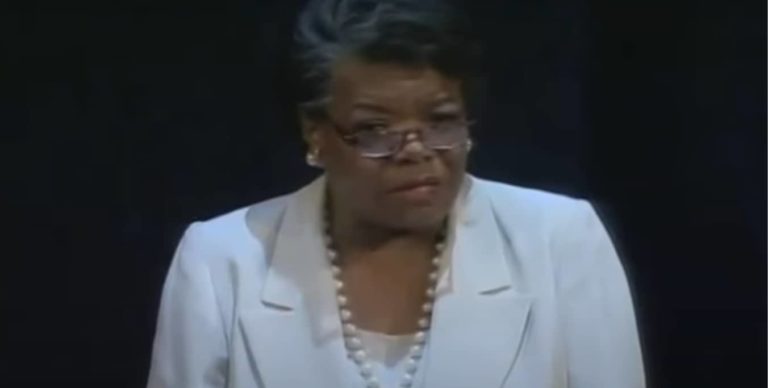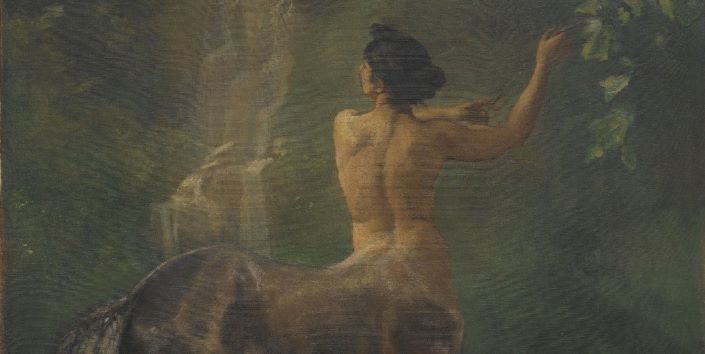Butter by Elizabeth Alexander
“Butter” a poem by American poet Elizabeth Alexander takes readers to her buttery childhood days. The fragrance of greasy butter and the addled sour taste ting our hearts while reading this piece. Broadly, it explores the themes of childhood, nostalgia, memory, and food. To be specific, this poem centers on how the poet’s mother added butter in all the recipes she cooked. She was quite fascinated with its taste and made her children like it (whether the speaker liked it, is not revealed it in the text). Besides, the mouth-watering imagery brings the taste of the recipes directly on readers’ taste buds. The poem appears in Alexander’s poetry collection, Body of Life (1996).
- Read the full text of “Butter“

Summary
The poem “Butter” is about how the poet’s mother cooked different recipes and added butter to them. It presents a wide variety of dishes alongside the poet’s feelings. In the first few lines of the text, the poet’s persona describes how her mother pulls chunks of butter with a stick and eats it plain. She is so fond of this milk product that she adds it to each item she cooks. Though the list is endless, the speaker mentions her top favorites. According to her, butter is included in turkey cutlets, green noodles, Yorkshire puddings, white rice, roasted corn, hominy grits, and sweet potato and pineapple pancakes.
By the end of the poem, Alexander digresses from her buttery food recipes and starts to talk about why her mother preferred butter so much. She added it to make her children’s skin glow from the inside out.
For a quick revision of the recipes mentioned in the poem, the following infographic can save readers a lot of time.
An Infographic of Her Mother’s Recipes

Meaning
The one-word title of the poem refers to the milk product, butter. Alexander uses this title to describe how the ingredient was part of her childhood. The first lines of the poem “My mother loves butter more than I do,/ more than anyone” give readers a hint regarding the main idea of this poem. It is about her mother’s fondness for butter. She added it to all the recipes she cooked at home. Starting from white rice to pancakes, cutlets to roasted corn, she did not ever forget to add a scoop or two of butter into the items. From the use of language, it is clear that Alexander and her brother also liked to have those dishes with butter.
However, in the end, the reason to add butter to each item is quite interesting. Her mother did so to make their skin more radiant, specifically “white”.
Form, Rhyme Scheme, & Meter
Form
The poem “Butter” is written in free-verse. It is told from the perspective of a first-person speaker who is none other than the poet Elizabeth Alexander herself. For this reason, it is an example of a lyric poem.
The overall poem contains a total of 25 lines grouped together in a single stanza. Alexander uses a number of cooking jargon throughout the piece. Apart from that, the poetic form of this piece resembles the features of modern poetry.
Rhyme Scheme
There is not any specific rhyme scheme in this poem. Alexander uses internal rhymings for creating a rhythm while reading. Readers can find regular rhyming in the following example:
- “picture”, “tiger”, and “are” (lines 18, 20, & 21)
Apart from that, there are several repetitions that help the poet create internal rhymings. For example, the term “butter” is used 14 times throughout the text.
Meter
This poem is written using iambic tetrameter alternatively. There are several metrical variations as well. Let’s have a look at the scansion of the first few lines:
My moth(e)r/ loves butt(e)r/ more than/ I do,
more than/ any-one./ She pulls/ chunks off
the stick/ and eats/ it plain,/ ex-plain(i)ng
cream spun/ a-round/ in-to butt(e)r!/ Grow-ing up
we ate tur-/key cut/-lets sauteed/ in lem(o)n
and butt(e)r,/ butt(e)r and/ cheese on/ green noodles
The major meter of this excerpt is iambic tetrameter. Alexander uses the following variations:
- Spondee: “loves butter,” “cream spun,” and “green noodles“
- Anapest: “in-to butter,” “Grow-ing up,” and “we ate tur(key)”
- Trochee: “butter and” and “cheese on”
Poetic Devices & Figurative Language
Alexander’s “Butter” showcases a variety of poetic devices that make the poetic thoughts more appealing to readers. Let’s have a look at the important devices used in this piece.
Repetition
The poem begins with a repetition of the phrase “more than”. It is used to emphasize how much the speaker’s mother loves butter. Readers can find the term “butter” is repeated a total of 14 times in the text.
Enjambment
It occurs throughout the poem. Alexander uses this device to internally connect the ideas of the lines and keep the pace unhindered. Let’s have a look at the following lines where this device is used:
more than anyone. She pulls chunks off
the stick and eats it plain, explaining
cream spun around into butter! Growing up
we ate turkey cutlets sauteed in lemon
and butter, …
Rhetorical Exclamation
The fourth line “… cream spun around into butter!” contains a rhetorical exclamation. It is used for describing how much the speaker’s mother loves to eat butter plain.
Alliteration
The repetition of similar sound or alliteration can be found in the following phrases:
- “My mother”
- “butter, butter”
- “butter better”
- “slipping squares”
- “with white”
- “pour/ over pancakes”
- “with warm”
- “good old days”
- “grinning greasy”
- “Mumbo and Jumbo’s,” etc.
Metaphor
- “small pools in the hearts/ of Yorkshire puddings” — The little hollows of a Yorkshire pudding is metaphorically compared to small pools. Whereas the overall pudding is compared to the human heart.
- “butter the lava in white volcanoes/ of hominy grits” — In this line, the “white volcanoes” are a metaphor for the hot-served hominy grits. The melted butter placed on top of it is compared to the lava.
- “I am grinning greasy” — Here, the smile of the speaker is compared to a greasy butter. As she ate butter in every foot item, her face had a greasy shine.
- “one hundred megawatts of butter” — In this line, Alexander uses a metaphor for comparing her shining to a 100 MW bulb.
Anaphora
Lines 10 and 12 begin with the same word “butter”. It is an example of anaphora.
Asyndeton
The poet does not use any conjunction while describing the dishes they ate in their childhood. It is an instance of asyndeton. Readers can find the use of this device starting from line 4 to 18.
Metonymy
In the line “I am grinning greasy”, Alexander uses metonymy for referring to the cause by presenting its effect. The speaker’s face looks greasy because she eats butter with every dish her mother cooked at home.
Paradox
This device is present in these lines “… having watched the tiger/ chase his tail and turn to butter.” How can a tiger turn into butter while chasing its tail? In reality, it is not possible. But, the speaker is hinting at the fact that for eating too much butter, they found the reflection of it in everything.
Allusion
The term “Mumbo Jumbo” contains an allusion to the speaker’s African descent.
Irony
Readers can find the use of irony in the last two lines of the poem:
our parent’s efforts, glowing from the inside
out, one hundred megawatts of butter.
Through these lines, the poet talks about how her parents thought by eating butter, their skin glow like whites. It is ironic to think that by eating butter one can glow “from the inside”.
Line-by-Line Analysis & Explanation
Lines 1-4
My mother loves butter …
… around into butter!
Elizabeth Alexander begins her poem “Butter” by talking about her fondness for butter. She uses hyperbole to express how much her mother likes butter. The phrase “more than anyone” is used for this purpose.
It is important to note what the first-person speaker remarks in the first line. She says that her mother loves butter more than she does. It hints at the fact that the speaker does not like butter that much.
Her mother likes butter more than anyone else. From this line, it can be inferred that her love for butter is quite unnatural. The following line gives more information regarding her unnatural fondness. According to the speaker, she pulls chunks of butter and eats it plain. It reveals her childishness. When the speaker asks her mother why she is eating it, she replies that cream spins around into butter.
Lines 4-6
… Growing up
…
… butter and cheese on green noddles,
In this section, the speaker begins to talk about how they ate butter with different dishes. The list starts from line 4 and ends in line 18. It is quite long. Let’s have a look at the items one by one.
While growing up, the speaker and her brother ate turkey cutlets. Their mother sauteed the cutlets in lemon and butter. “Sauté” is a French verb that means to fry quickly in a little hot fat. Here, Alexander uses kinesthetic imagery of cooking sauteed cutlets.
The next dish is green noodles. Their mother fried the noodles in butter and cheese. Readers can understand that she was fascinated with all the milk products, starting from butter to cheese.
The structure of the lines makes one quickly read the lines, one after another. Besides, there is no conjunction in the lines. Alexander omits conjunctions from the text to quicken the pace.
Lines 7-9
butter melting in small pools …
… staining white rice yellow,
The third dish is Yorkshire pudding. For those who are not familiar with this dish, it is a common English side dish. This pudding can be served in several ways depending on the choice of ingredients. The speaker’s mother put butter inside “the hearts” of the pudding. It is a reference to the tiny curves over the pudding. Her mother put so much butter on top of the hot pudding that it formed little “pools”.
The fourth item is white rice. They preferred to have butter with rice instead of gravy. For using butter, the rice stained yellow. Here, the poet uses visual imagery to depict the rich yellow color of butter.
Lines 10-18
butter glazing corn in …
… warm Alaga syrup.
Then comes the fifth food item where butter is used. It is “glazing corn”. The corn does not glaze naturally. For using butter on it, it is shining. After roasting it, her mother poured squares of butter on it. The butter melted and slowly slipped down.
In the following lines, the speaker talks about “butter the lava”. This phrase contains a comparison between hot butter and lava. Where is it used? Moreover, her mother applied it in “white volcanoes of hominy grits”. Hominy grits, a type of porridge, are made from hominy corn. The speaker compares the surface of the grit to a volcano and the butter spread over it to lava.
The following lines (12-18) contain the preparation of pancake and how her mother used butter in each step. Firstly, she mixed it with white sugar. Then she added the mixture to the mixture of whipped sweet potatoes and pineapple. When the pancake was taken out from the oven, her mother garnished it with butter and Alaga syrup. The speaker beautifully illustrates how butter melted on the pancake. She licked the last bit of butter off the plate. It was so delicious!
Lines 18-25
… When I picture
…
… one hundred megawatts of butter.
A digression occurs in line 18. In this section, the speaker becomes nostalgic of her childhood days. She remembers the “good old days” when she and her brother grinned while watching turning into butter. They ate butter in such quantities that they hallucinated it in everything.
She alludes to her African descent by the phrase “Mumbo and Jumbo’s children”. The “historical revision” is a reference to the fact that Alexander had an African-American bloodline.
By the following lines, it becomes clear why they ate butter with every dish. Butter is a rich source of fatty acids and vitamin A that brings a natural white glow to the skin. Their mother fed them butter for this reason. At last, the speaker humorously remarks that their parents were successful as their skin glowed like a one-hundred-megawatt bulb.
Historical Context
The poem “Butter” was first published in Elizabeth Alexander’s poetry collection Body of Life. It was published in 1996. Alexander’s mother belongs to the Logan family. The Logan family are African Americans descended from Warren Logan and his wife Adella Hunt Logan. The family is part of the African-American upper class. In this poem, Alexander refers to their descent in the last few lines. Besides, she talks about her childhood when her mother (Adele Logan Alexander) cooked them several dishes with butter.
Questions & Answers
This poem is about the poet’s mother and how she cooked different dishes with butter.
This poem was published in 1996 in Elizabeth Alexander’s poetry collection Body of Life.
This poem centers on how the poet’s mother cooked several dishes with butter. Her fondness for it is displayed in this poem.
Elizabeth Alexander’s “Butter” taps on the themes of childhood, nostalgia, memory, butter, and food.
The speaker of this piece is none other than the poet Elizabeth Alexander herself.
Similar Poems about the Parent-Child Relationship
- “My Mother at Sixty-Six” by Kamala Das – It’s about how the poet left her old mother.
- “I Shall Paint My Nails Red” by Carole Satyamurti – It’s about the desire of a woman to paint her nails in a bold red color and thus assert her identity as a woman.
- “Fear” by Gabriela Mistral – This poem is about a mother’s fear of her child’s future.
- “Eating Together” by Li-Young Lee – It’s about how a speaker misses his deceased father at the time of having lunch with his family.
External Resources
- The Poem Aloud — Listen to an incredible reading of the poem.
- About Elizabeth Alexander — Read more about the poet’s biography and her works.
- Elizabeth Alexander’s Poet Profile and Poems — Explore some of Alexander’s best-known poems and her short biographical sketch.
- Poet Natasha Trethewey Interviews Elizabeth Alexander — Learn about the themes of the poet’s works and her commentary on her own poems.
- Why Obama selected Elizabeth Alexander for his inauguration — Alexander read her poem “Praise Song for the Day” at Obama’s presidential inauguration ceremony on January 20, 2009. Read why Obama chose her to read the poem at his inauguration.






